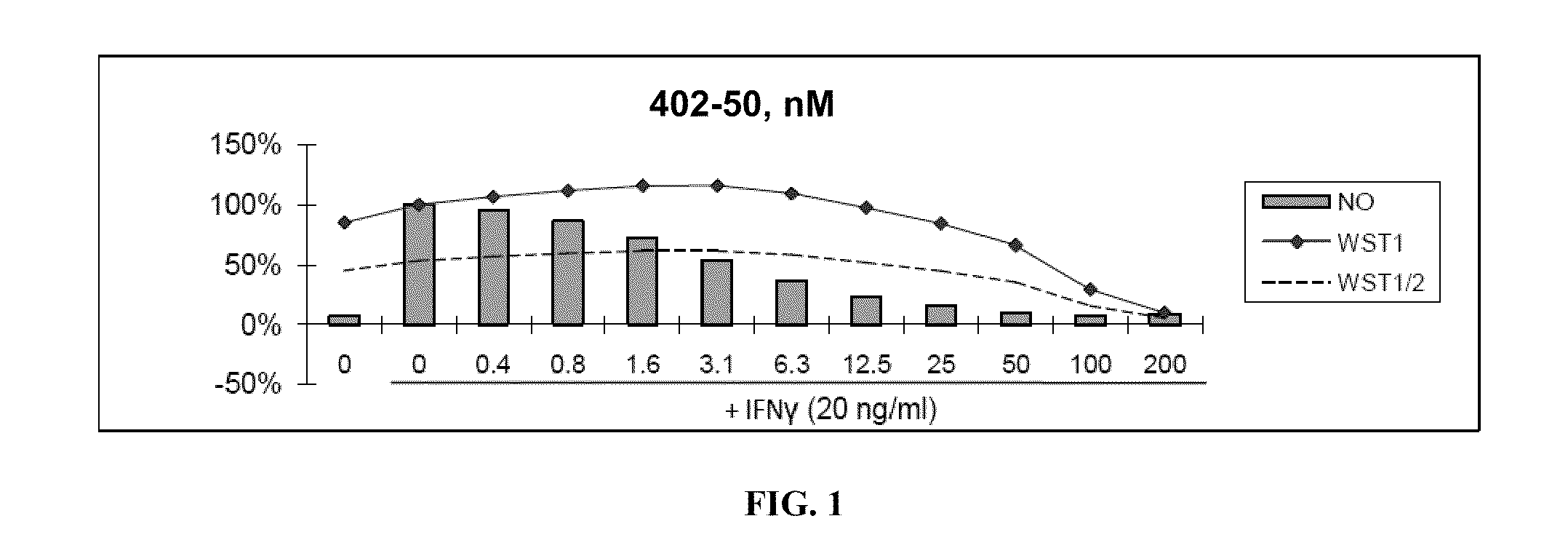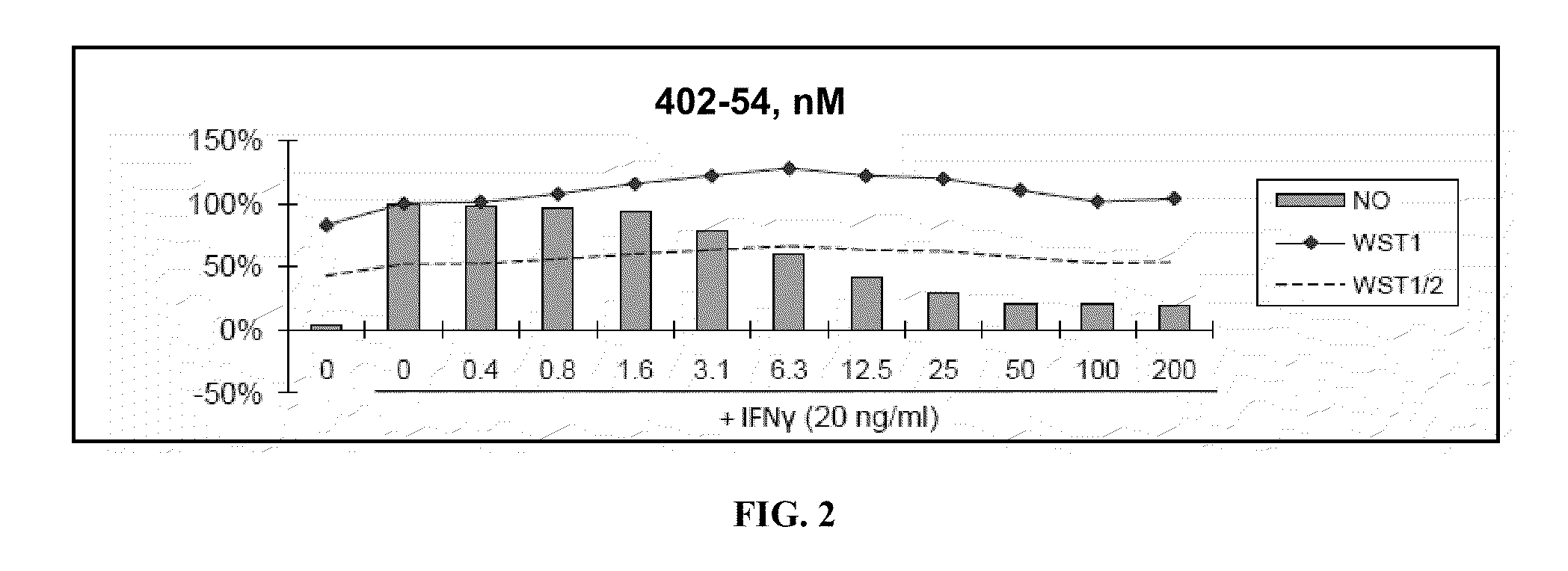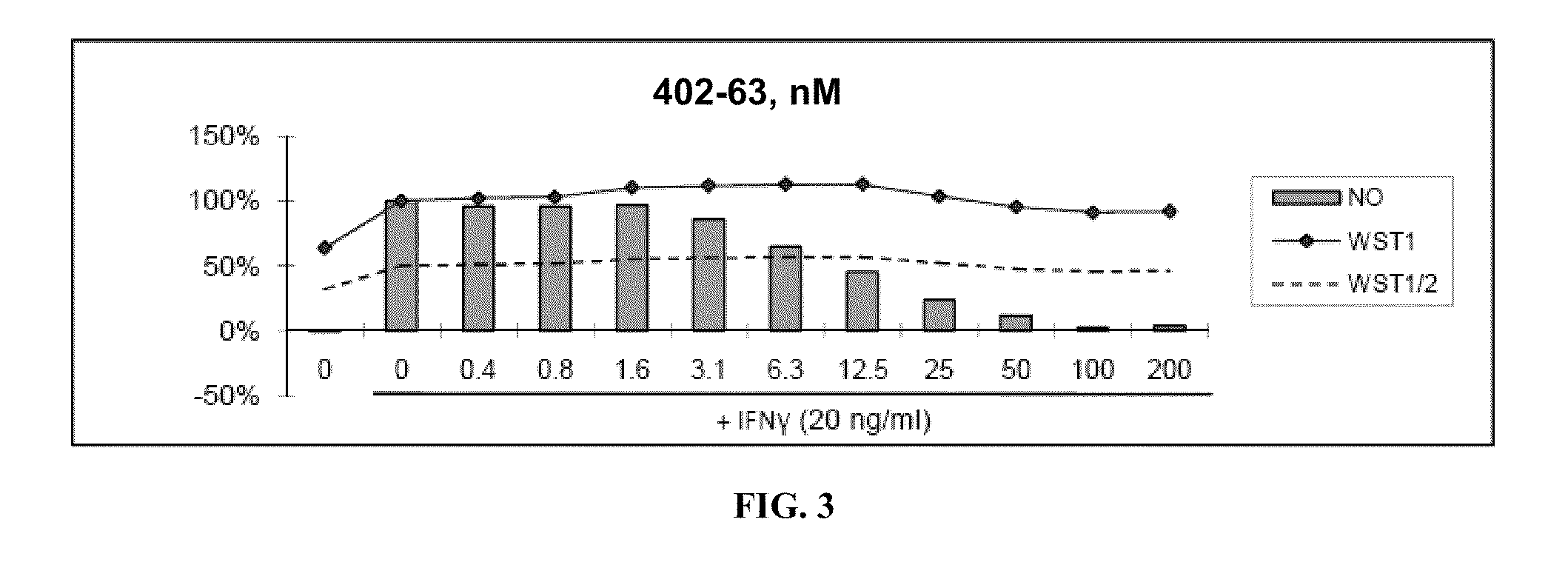Antioxidant inflammation modulators: C-17 homologated oleanolic acid derivatives
a technology of oleanolic acid and antioxidant inflammation, which is applied in the field of biochemistry and medicine, can solve the problems of smoldering inflammation, drugs, and unsuitable for chronic use, and achieve the effect of improving the glomerular filtration rate or creatinine clearan
- Summary
- Abstract
- Description
- Claims
- Application Information
AI Technical Summary
Benefits of technology
Problems solved by technology
Method used
Image
Examples
example 1
Methods and Materials
[0480]Nitric Oxide production and cell viability. RAW264.7 macrophages were pre-treated with DMSO or drugs for 2 hours, then treated with recombinant mouse IFNγ (Sigma) for 24 hours. NO concentration in media was determined using the Griess reagent system (Promega). Cell viability was determined using WST-1 reagent (Roche).
[0481]STAT3 phosphorylation. HeLa cells were treated with the indicated compounds and concentrations for 6 hours and subsequently stimulated with 20 ng / ml recombinant human IL-6 (R&D Systems) for 15 minutes. Lysates were immunoblotted with antibodies against phosphorylated or total STAT3 (Cell Signaling).
[0482]NF-κB activation. HeLa cells were transfected with pNF-κB-Luc (inducible, Stratagene) and pRL-TK (constitutive, Promega) reporter plasmids. Twenty-four hours later cells were pre-treated with the indicated compounds for 2 hours. DMSO served as a vehicle control. Following pre-treatment, cells were stimulated with 20 ng / ml recombinant hum...
example 2
Synthesis of Oleanolic Acid Derivatives
[0522]
[0523]Reagents and conditions applicable to Scheme 1 are: (a) LAH, rt to 65° C., 1.5 h, 52% (compound 2) and 27% (compound 3). Compound 2 was transformed to compound 402-63 in five steps (Scheme 2). Compound 2 was treated with bleach, selectively oxidizing the two secondary alcohols to give compound 4 in 83% yield. Formylation of 4 with ethyl formate using sodium methoxide as the base afforded compound 5, which was treated with hydroxylamine hydrochloride in aqueous EtOH at 60° C. to give isoxazole 6 in 76% yield (from 4). Cleavage of the isoxazole under basic conditions gave α-cyanoketone 7 in quantitative yield as a mixture of ketone and enol forms. Compound 7 was treated with 1,3-dibromo-5,5-dimethylhydantoin, followed by elimination of HBr using pyridine as the base, to give compound 402-63 in 79% yield. Treating the alcohol 402-63 with Ac2O / Pyridine gave 402-65 in 70% yield.
[0524]
[0525]Reagent and conditions applicable to Scheme 2 ar...
example 3
Characterization of Certain Oleanolic Acid Derivatives
[0577]Compounds 2 and 3: LiAlH4 solution (1.0 M in THF, 42 mL, 42 mmol) was added to a solution of compound 1 (5.0 g, 10.3 mmol) in THF (100 mL) at room temperature under N2. After stirring for 20 min at room temperature, LiAlH4 solution (1.0 M in THF, 21 mL, 21 mmol) was added again and the reaction mixture was refluxed for 1 h. After cooling to 0° C., water (10 mL) was added dropwise, followed by the addition of 1N HCl (aq) (300 mL). The mixture was extracted with EtOAc. The combined extracts were washed with water, dried with MgSO4, and concentrated. The residue obtained was mixed with CH2Cl2 (200 mL). The white solid that precipitated was collected by filtration and washed with CH2Cl2 (2×100 mL) to give compound 3 (500 mg, 10%). The combined filtrate was loaded on a silica gel column and eluted with 0% to 100% EtOAc in hexanes to give compound 2 (2.60 g, 52%) and additional compound 3 (800 mg, 17%). Both compounds 2 and 3 are...
PUM
| Property | Measurement | Unit |
|---|---|---|
| concentrations | aaaaa | aaaaa |
| temperature | aaaaa | aaaaa |
| temperature | aaaaa | aaaaa |
Abstract
Description
Claims
Application Information
 Login to View More
Login to View More - R&D
- Intellectual Property
- Life Sciences
- Materials
- Tech Scout
- Unparalleled Data Quality
- Higher Quality Content
- 60% Fewer Hallucinations
Browse by: Latest US Patents, China's latest patents, Technical Efficacy Thesaurus, Application Domain, Technology Topic, Popular Technical Reports.
© 2025 PatSnap. All rights reserved.Legal|Privacy policy|Modern Slavery Act Transparency Statement|Sitemap|About US| Contact US: help@patsnap.com



